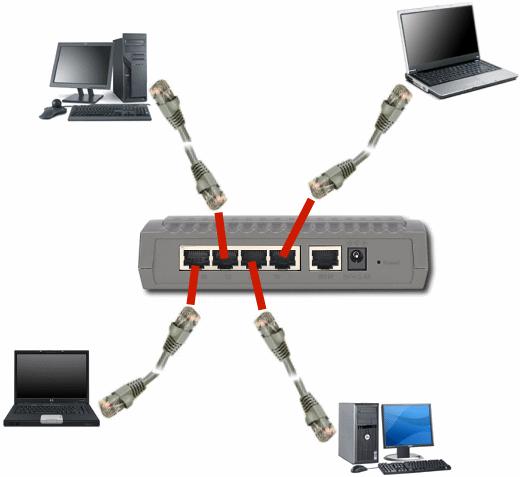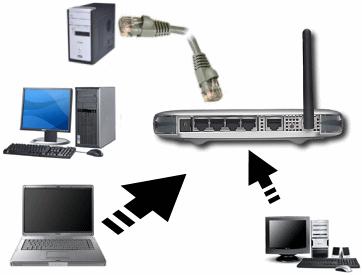Networking computers
Introduction
Computer networking is a term that is used to refer to the interconnection of computers so as to facilitate communication and share resources. Computer networks can be classified according to a variety of characteristics such as the medium which is used to transport data. Networks can also be classified depending on the method of connection used. We can have wired computer networks or wireless computer networks. A wired computer network uses cables to interconnect different computers in the setup while the wireless networks do not use any kind of physical connection. In wireless networks we can use Bluetooth, infrared rays and other forms of radio waves to send signals across the networks. Networks can also be classified according to the type of topology which is used for the connection. There are several types of topologies which can be used. They include:
Types of topologies
Network topology is the layout which is used for the interconnections of the computer nodes in a network. The most common types of layouts which are in use include:
A bus network – in this setup, all nodes are connected to a common medium. The medium then interconnects all the other computers in the network.
Star network – all the nodes are connected to a central node. The node serves as the core of the network whereby all communications to the rest of the network must pass through.
Ring network – in this setup, each node is connected to its adjacent neighbor. The communications can be either leftwards or rightwards of each node.
Mesh network – this is a situation whereby each node is connected to an arbitrary number of neighbors so that there is more than one channel of communication for every node in the network.
There are two types of networking namely:
Peer-to-peer networking
A network can be referred to as peer-to-peer if most of the computers in the network are similar and run workstation operating systems. In a Peer-to-peer networking, each computer holds its files and resources. Other computers in the network can then be able to access these resources through a wired or a wireless channel. A computer containing some given set of information has to be turned on so that other computers can be able to access these resources.
Client/Server Networking
A computer network can be called a client/server if at least on of the computers in the network is being used to serve other computers in the network. The server must have higher specifications than the clients that it is to serve. In this setup, each computer will still hold its resources but there are some files that are centralized and they are usually found in the server. This type of setup has very many advantages over the peer-peer network since controlling and managing of resources is made very easy.
In our case we are not going to use this type of networking since the computers that need to be connected are similar and we just want to make it possible to share resources on those four computers across the network.
A workstation is a computer on which a person performs regular assignments. Any modern computer can be used as a work station. Before beginning to build a computer network you need to lay down proper plans on how the network is going to operate. When planning, you need to check the hardware parts of the computer and ensure that they meet the minimum specifications for them to operate in the network.
- Processor – the processor should have at least 300 MHZ. checking the processor speed of the computer you can perform the following.
- When the computer starts, press F2 or F8 depending on the computer model you are using so as to access the BIOS. The processor speed can be seen at the BIOS setup.
- When the computer is running on Windows 95 or a later version of Microsoft operating system, right click on the My Computer Icon and choose Properties. You will be able to see the processor speed there.
- You can also open the control panel and double-click on System
- RAM (Random Access Memory) – the RAM for every computer must be above 64 MB. Checking the computer’s RAM is similar to checking the computer’s processor speed. To check the computer memory perform either of the following:
- When the computer starts, press F2 or F8 depending on the computer model you are using so as to access the BIOS. The processor speed can be seen at the BIOS setup.
- When the computer is running on Windows 95 or a later version of Microsoft operating system, right click on the My Computer Icon and choose Properties. You will be able to see the processor speed there.
- You can also open the control panel and double-click on System
- Hard Drive – There should be enough space in the computer’s hard drive so that it can be possible for the installation of Windows XP. To check the remaining space open My computer and write click on the icon for computer hard drive. Choose properties and you will be able to see the remaining space on the hard drive. The hard drive space should be at least 10 GB so as to allow for the installation of the Windows XP and some basic software.
In order to connect computers on the network, we can use either cable to connect or connect them using a wireless technique. Using cables is much easier and less expensive since it does not require the purchase of additional hardware. A well laid conduit for the passage of cables can be very organized that a person may not know that the connection is done using a wired method. The following items need to be purchased.
- RJ 45
- Cat 5cable
- A crimping tool (though you can ask the crimping job be done for you at the store where you purchase the network cables and the RJ 45 clips)
The connection can be done via serial ports. However, in case whereby you need to use more than two computers, serial connections may not be practical. Since in your case you need to interconnect four PCs, a central device like a switch, a router or a hub can be used for the connection of the computers. I would recommend the use of a switch since it’s is relatively cheaper than a router and also more intelligent than a hub. A router would be more ideal if you want to have some form of internet connection.
After the installation of the operating system, you need to connect the computers so that you can be able to share resources. The cables should already have been crimped. Check the back of each computer for the NIC card. Plug the cables to the NIC card at the RJ 45 slot. The other end of the cable should be connected to a switch or a router. After connecting all the four computers, the setup should be similar to the representation shown below:

Switch on all the computers and the switch. You need to change the work group name for the computers so that you have a common work group name. to change the work group name, perform the following:
- Right click on the MY Computers Icon on the desktop
- hoose properties
- Click on Computer Name
- Click on Change
- On the box labeled work group, rename the workgroup to a name of you choice
- Click okay and you will be required to restart the computer
- Restart the computer whenever prompted to do so
- Repeat this procedure for all the four computers
- Once all the computers have been restarted, you can start the configuration for the network
Network configuration
- Right click on the MY Network Places Icon
- Choose Properties
- Right Click on the Icon of Local Area Connection and choose properties
- Click on the Internet Protocol (TCP/IP) and click properties
- Click on the radio button use the following IP address
- In the box for IP address, type the following address:
- 192.168.0.1 for the first computer
- 192.168.0.2 for the second computer
- 192.168.0.3 for the third computer
- 192.168.0.4 for the fourth computer
- Click OK and the configuration will be saved
NB. The last two addresses can be changed to any value of your choice but ensure that the values do not exceed 255.
Once you are through with the configuration, you can share resources. To share resources perform the following:
- Right click on the folder or on the item to be shared
- Choose sharing and security
- Click on the link : if you understand the risk
- Choose the radio button – just enable file sharing
- Click okay and the configurations will be saved.
You are now ready to share resources and access all the shared resources across the network.
For wireless connections, the configuration process is the same and you have to use the router address on the box for gateway address. A wireless setup is similar to the diagram shown below:

References
Shelly, Gary, et al. (2003) Discovering Computers
Cisco Systems, Inc., (2003) CCNA: network media types.
Wendell Odom,Rus Healy, Denise Donohue. (2010) CCIE Routing and Switching. Indianapolis, IN: Cisco Press
Odom, Wendall, (2010) CCNA Certification Guide